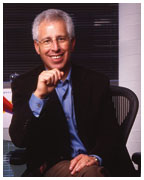
|
March 7, 2007: A moment with...
(Webb Chappell/courtesy MIT) |
Frank Moss ’71
When MIT approached Frank Moss ’71 about running the school’s famed Media Lab — an interdisciplinary digital incubator — Moss, the entrepreneur behind software maker Tivoli Systems and biotech company Infinity Pharmaceu-ticals, just laughed. “It was out of left field, so I said, ‘You’ve got to be kidding,’” he recalls. But Moss, who earned his Ph.D. in aeronautics and astronautics at MIT, slowly warmed to the idea of “using what I know to help people,” and started there in February 2006. The one-time mechanical and aerospace engineering major spoke with Matthew Boyle ’97, a writer at Fortune magazine.
What did you know about the Media Lab before taking the job?
I knew a bit about it. It was a mecca in the 1980s and 1990s for people interested in everything digital. I also knew that it was past its prime. Places like this are not receiving the funding they were getting in the salad days.
Was a new approach necessary?
The old model was serendipity. The lab’s annual budget is more than $30 million, and the majority is funded by companies like Motorola, Samsung, and Lego. They would hopefully get some epiphany that would result in a new market. But coming from industry, I know that now, post-bubble, post- 9/11, businesses are looking to get a return on their investment — bang for their buck. We have to find ways to connect the sponsors with research in a tangible way. It’s not just, “Give us your money and we’ll do what we want.”
How is this new approach reflected in the research done?
Over the past 20 years, “digital” has been all about lifestyle — to entertain ourselves better, to buy things in a more efficient way, or to communicate with others. In the next 20 years it will be about a better future. That has an impact on our quality of life in a way that’s much deeper than the next gadget. Youtube.com is wonderful, but we have problems in our society today, like autism, Alzheimer’s, and aging. The heart and soul [of the lab] is not about the next gizmo. It’s about people.
Can you give some examples?
We’re busy redefining our definition of basic human abilities. One project is emotional prostheses. Autistic kids, for reasons we don’t know, cannot make eye contact with others. If someone is mad or bored they don’t connect, and that limits their ability to interact. We have developed an emotional prosthetic that enables [an autistic person] to understand the emotions of others from a camera hidden in their eyeglasses. It analyzes facial expressions digitally and then signals to them in simple terms, enhancing their ability to communicate.
Another area is called “neuromedia,” or how you can get information from your brain to a cell phone in a way that doesn’t require you to use a keyboard. It could help quadriplegics, and eventually could impact how we interact with technology in the future.
What about robotics?
One of our robot projects is called The Huggable, a teddy bear. We’ve taken a popular brand of teddy bear, removed the guts, and put in very sophisticated technology like vision and sensors. We’re introducing them to chronic-care hospitals in the Boston area, where kids cannot have pets. The kids are happier and more communicative, and we think hospital stays will be shortened.
We’re also building a car in collaboration with General Motors, called the City Car, which folds up like a shopping cart. Each of the wheels of this robotic vehicle contains the entire engine, suspension, and transmission. You can stack them right in the middle of a city, and they can turn on their axes. It’s amazing.
What classes at Princeton do you recall fondly?
I had one with engineering professor Courtland Perkins, who was the chair of the aerospace department. He was an expert in aircraft design. One time we went out to the Forrestal campus, where they had wind tunnels dating from World War I. I decided to study the aerodynamics of the boomerang. I mounted one on top of a hand drill and put it inside the famous wind tunnel. Well, the boomerang broke off the drill and flew into a 12-foot wooden propeller. We ran out of there. In the morning, I had a bout of guilt and confessed. They looked into the tunnel and said, “Well, it’s no more dented than it’s been before.”
What about classes outside engineering?
I took philosophy courses with Walter Kaufmann. That was challenging
because he was a Nietzsche expert, and I associated Nietzsche with the
Nazi movement. That was a really cool class. We’d sit around with
brandy in precept, and I just tried to keep up. I learned what it was
like to go outside your comfort zone, and that helped me later in life.
![]()

